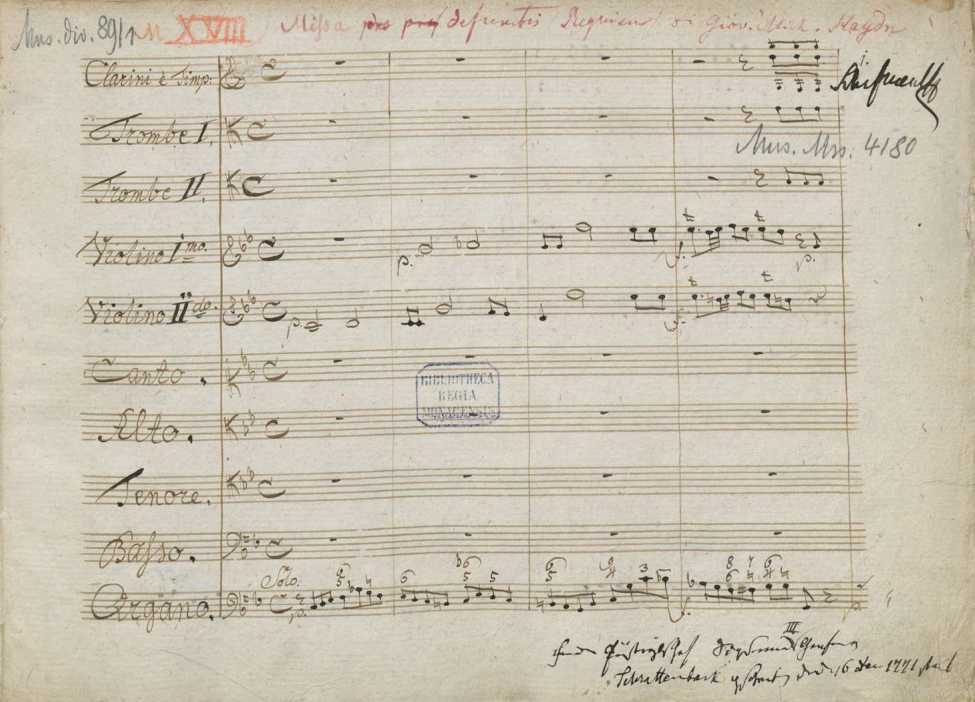Requiem Pro Defuncto Archiepiscopo Sigismundo on:
[Wikipedia]
[Google]
[Amazon]
 The mass is scored for the vocal soloists and mixed choir, two
The mass is scored for the vocal soloists and mixed choir, two
Michael Haydn
Johann Michael Haydn (; 14 September 173710 August 1806) was an Austrian composer of the Classical period, the younger brother of Joseph Haydn.
Life
Michael Haydn was born in 1737 in the Austrian village of Rohrau, near the Hungarian border. ...
wrote the Missa pro defuncto Archiepiscopo Sigismondo, or more generally Missa pro Defunctis, Klafsky I:8, MH 155, following the death of the Count Archbishop Sigismund von Schrattenbach in Salzburg in December 1771. Haydn completed the Requiem
A Requiem or Requiem Mass, also known as Mass for the dead ( la, Missa pro defunctis) or Mass of the dead ( la, Missa defunctorum), is a Mass of the Catholic Church offered for the repose of the soul or souls of one or more deceased persons, ...
before the year was over, signing it "S liD oH noret G oria.Salisburgi 31 Dicembre 1771." At the beginning of that year, his daughter Aloisia Josefa died. Historians believe "his own personal bereavement" motivated the composition. Contemporary materials which have survived to the present day include the autograph score found in Berlin, a set of copied parts with many corrections in Haydn's hand in Salzburg and another set at the Esterházy castle in Eisenstadt
Eisenstadt (; hu, Kismarton; hr, Željezni grad; ; sl, Železno, Bavarian language, Austro-Bavarian: ''Eisnstod'') is a city in Austria, the state capital of Burgenland. It had a recorded population on 29 April 2021 of 15,074.
In the Habsburg ...
, and a score prepared by the Salzburg copyist
A copyist is a person that makes duplications of the same thing. The term is sometimes used for artists who make copies of other artists' paintings. However, the modern use of the term is almost entirely confined to music copyists, who are emplo ...
Nikolaus Lang found in Munich.
Instrumentation
 The mass is scored for the vocal soloists and mixed choir, two
The mass is scored for the vocal soloists and mixed choir, two bassoon
The bassoon is a woodwind instrument in the double reed family, which plays in the tenor and bass ranges. It is composed of six pieces, and is usually made of wood. It is known for its distinctive tone color, wide range, versatility, and virtuo ...
s, four trumpets in C, three trombones, timpani and strings with basso continuo.
Structure
The composition is structured in the following five parts: #Requiem aeternam Adagio, C minor, common time # Sequentia Dies irae Andante maestoso, C minor, 3/4 # Offertorium Domine Jesu Christe #:* "Rex gloriae" Andante moderato, G minor, common time #:* "Quam olim Abrahae" Vivace, G minor, cut time #:* "Hostias et preces" Andante, G minor, common time #:* "Quam olim Abrahae" Vivace e più Allegro, G minor, cut time #Sanctus Andante, C minor, 3/4 #:* "Benedictus qui venit..." Allegretto, E-flat major, 3/4 #Agnus Dei et Communio #:* "Agnus Dei, qui tollis peccata mundi" Adagio con moto, C minor, common time #:* "Cum sanctis tuis" Allegretto, C minor, cut time #:* "Requiem aeternam" Adagio, C minor, common time #:* "Cum sanctis tuis" Allegretto, C minor, cut timeTempo
Sherman recommends a tempo relation in which "in ''Agnus Dei et Communio'', the of both ''Agnus Dei'' and ''Requiem aeternam'' equals of the fugue ''Cum sanctis tuis''." Sherman also recommends interpreting the Andante maestoso of the Dies Irae at "a pulse of = MM. 104."Leopold Mozart
Johann Georg Leopold Mozart (November 14, 1719 – May 28, 1787) was a German composer, violinist and theorist. He is best known today as the father and teacher of Wolfgang Amadeus Mozart, and for his violin textbook ''Versuch einer gründlichen ...
instructs "that the staccato indicates a lifting of the bow from the string" with no accent implied.
Influence in Mozart's Requiem
Both Leopold and his son Wolfgang Amadeus Mozart were present at the first three performances of Haydn's Requiem in January 1772, and Wolfgang was influenced in the writing of his own Requiem in D minor, K. 626. In fact, Michael Haydn's Requiem is "an important model for Mozart" and strongly suggests thatFranz Xaver Süssmayr
Franz Xaver Süssmayr (German: ''Franz Xaver Süßmayr'', or ''Suessmayr'' in English; 1766 – September 17, 1803) was an Austrian composer and conductor. Popular in his day, he is now known primarily as the composer who completed Wolfgang Amad ...
's completion of Mozart's way does not depart "in any way from Mozart's plans."p. 70 (1998) Wolff
Notes
References
* Heartz (1995) Daniel. New York. ''Haydn, Mozart, and the Viennese School: 1740 — 1780'' W. W. Norton & Co. * Sherman (1969) Charles. Mainz Foreword to ''Missa pro Defunctis'' Universal Edition * Wolff (1998) Christoph. Berkeley, California ''Mozart's Requiem: Historical and Analytical Studies, Documents, Score'' University of California Press {{Authority control Compositions by Michael Haydn Haydn, Michael 1771 compositions